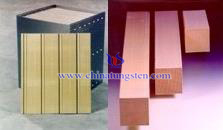CaO Effects Designing WO3 Denitration Catalyst
- Details
- Category: Tungsten Information
- Published on Wednesday, 13 April 2016 18:19
 Calcium oxide (CaO), the so-called quicklime, is an inorganic compound powder with white, hygroscopic and corrosive. The plaster (Calcium sulfate) in thermal power plant is generated by sulfur dioxide reacting with desulfurization and then oxidized, and then discharged with the flue gas exhaust system. When it comes into being that calcium sulfate contacts with tungsten trioxide SCR denitration catalyst, large number of calcium sulfate will be deposited on the surface of the catalyst, which can cause the catalyst surface shielding, and then the catalyst activity decreased.
Calcium oxide (CaO), the so-called quicklime, is an inorganic compound powder with white, hygroscopic and corrosive. The plaster (Calcium sulfate) in thermal power plant is generated by sulfur dioxide reacting with desulfurization and then oxidized, and then discharged with the flue gas exhaust system. When it comes into being that calcium sulfate contacts with tungsten trioxide SCR denitration catalyst, large number of calcium sulfate will be deposited on the surface of the catalyst, which can cause the catalyst surface shielding, and then the catalyst activity decreased.
By the time the content of calcium oxide in the flue gas is less than 5%, little effect has occurred on catalyst design. However, when the content of calcium oxide is more than 5%, its effect on the catalyst design generates becomes very large. With the calcium oxide content increasing, the amount of tungsten trioxide SCR denitration catalyst turns to linearly increasing trend, especially when the calcium oxide content is about 30%, the consumed catalyst required will increase about 25% compared with low calcium conditions. In this condition, catalyst activity and aging speed can’t overestimate when design catalyst; in order to ensure the chemical catalyst lifetime (24,000 hours), we need to leave enough adequate catalyst, thus will result in a larger number of design volume and costs increased.
Therefore, in the high calcium conditions, the blind pursuit of a minimum amount of tungsten trioxide SCR denitration catalyst will result in a short life of the catalyst, reduction denitration efficiency decreased and other adverse consequences. Besides, if we ignore the impact of calcium on the running of catalyst, reduce design margins unprincipled, overestimated the catalyst activity, the risk of high operating costs will present although it bring cost savings to some extent. It is worth mentioning that, the presence of tungsten trioxide can effectively inhibit the sintering of the catalyst particles, delaying the degree of sintering, therefore, tungsten trioxide SCR denitration catalyst is particularly suitable for high calcium conditions.
| Tungsten Oxide Supplier: Chinatungsten Online www.tungsten-oxide.com | Tel.: 86 592 5129696; Fax: 86 592 5129797;Email:sales@chinatungsten.com |
| Tungsten News & Prices, 3G Version: http://3g.chinatungsten.com | Molybdenum News & Molybdenum Price: http://news.molybdenum.com.cn |